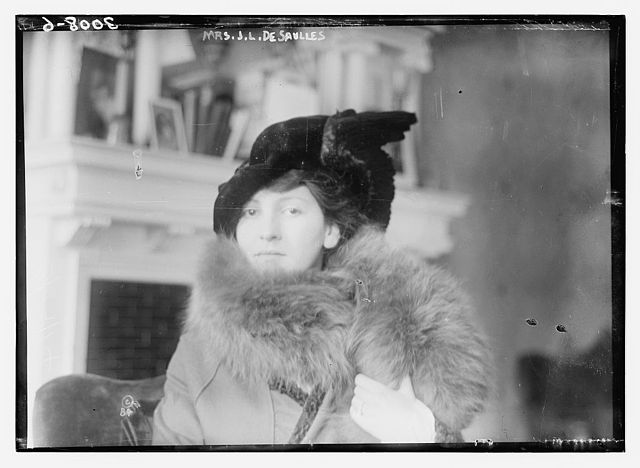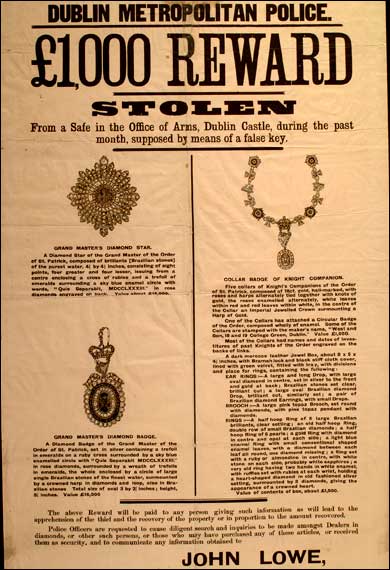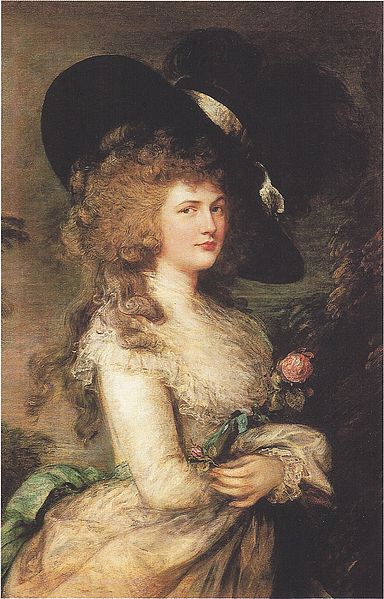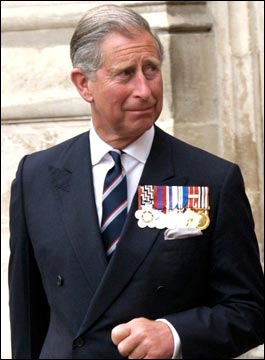
The great deterrent against crime is not vindictive punishment; the more certain you make detection, the less severe your punishment may be. The brilliant sleuth-hound work of which we read so often is a less important factor in police work than organisation. Organisation it is which holds the peace of London. It is organisation that plucks the murderer from his fancied security at the ends of the earth, that prevents the drunkard from making himself a nuisance to the public, that prevents the defective motor-bus from becoming a danger or an annoyance to the community.
Inside the building of red brick and grey stone that faces the river, and a stone’s throw from the Houses of Parliament, there are men who sit planning, planning, planning. The problems of the peace of London change from day to day, from hour to hour, almost from minute to minute. Every emergency must be met, instantly, as it arises—often by diplomacy, sometimes by force. A hundred men must be thrown here, a thousand there, and trained detectives picked for special work. With swift, smooth precision, the well-oiled machinery works, and we, who only see the results, never guess at the disaster that might have befallen if a sudden strain had thrown things out of gear.
In the tangle of departments and sub-departments, bewildering to the casual observer, there is an elastic order which welds the whole together. Not a man but knows his work. The top-notch of efficiency is good enough for Scotland Yard. Its men are engaged in business pure and simple, not in making shrewd detective deductions. The lime-light which occasionally bursts upon them distorts their ways and their duties. Really, they have little love for the dramatic. Newspaper notoriety is not sought, and men cannot “work the Press,” as in times gone by, to attain a fictitious reputation.
It is through well-chosen lieutenants that Sir Edward Henry works. There are four Assistant-Commissioners upon each of whom special work devolves. Sir Frederick Wodehouse, for instance, is the “Administrative Assistant-Commissioner.” He deals with all matters relating to discipline, promotion, and routine so far as the uniformed force is concerned.
The Criminal Investigation Department is under Mr. Basil Thompson, a comparatively young man who came from the Prison Commission to succeed Sir Melville Macnaghten, and who has successfully experimented with some new ideas to make the path of the criminal more difficult. Mr. Frank Elliott, who was formerly at the Home Office, holds sway over the Public Carriage Office; and the Hon. F. T. Bigham, a barrister—and a son of Lord Mersey, who gained his experience as a Chief Constable of the Criminal Investigation Department—deals with and investigates the innumerable complaints and enquiries that would occur even in a police force manned by archangels. Mr. Bigham is also the Central Authority under the terms of the international agreement for the suppression of the white slave traffic.
There are six Chief Constables, mostly ex-military officers. One of these assists in the administration of the Criminal Investigation Department, the remainder control districts of four or five adjoining divisions. To adopt a military simile, they may be compared to major-generals in command of brigades, with each division representing a battalion, and the superintendents, colonels.
Only once in the whole history of the Metropolitan Police has a man risen from the ranks to the post of Chief Constable, though many, like Mr. Gentle at Brighton, and Mr. Williams at Cardiff, have become the heads of important provincial forces. The post of superintendent in London is at least equivalent in its responsibilities to the average chief-constableship of the provinces. There are metropolitan section sergeants who have as many men under their control as some chief constables of small boroughs.
The unit of the Metropolitan Police is a division which averages about a thousand men. Each is under a superintendent, with a chief-inspector as second in command. Thereafter the ranks run:
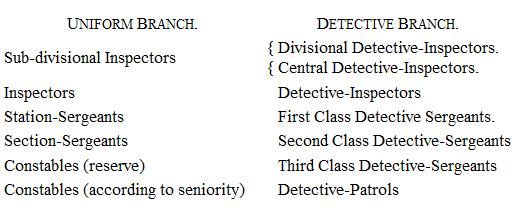
These are distributed among close on two hundred police stations in the metropolis, and in twenty-two divisions. Some are detailed for the special work with which London as London has nothing to do. Thus there are: the King’s Household Police; divisions guarding the dockyards and military stations at Woolwich, Portsmouth, Devonport, Chatham, and Pembroke; detachments on special duty at the Admiralty and War Office and the Houses of Parliament and Government Departments; and men specially employed, as at the Royal Academy, the Army and Navy Stores, and so on. In all, there are 1,932 men so engaged. Their services are charged for by the Receiver, and the cost does not fall upon the ratepayers.
Scotland Yard is run on the lines of a big business. To the intimate observer it is strangely similar in many of its aspects to a great newspaper office, with its diverse and highly specialised duties all tending to one common end. The headquarters staff is a big one. There are superintendents in charge of the departments, men whom no emergency can ruffle—calm, methodical and alert, ready to act in the time one can make a telephone call.
There are McCarthy, of the Central Criminal Investigation Department; Quinn, of the Special Branch which concerns itself with political offences and the care of Royalty; Bassom, of the Public Carriage Department; Gooding, of the Peel House Training School; West and White, of the Executive and Statistical Departments.
Nothing but fine, careful organisation could weld together these multitudinous departments with their myriad duties. It is an organisation more difficult to handle than that of any army in the field. The public takes it all for granted until something goes wrong, some weak link in the chain fails. Then there is trouble.
The Metropolitan Police is the only force in England which is independent of local control. The Commissioner—often wrongly described as the Chief Commissioner—is appointed by the Crown on the recommendation of the Home Secretary, and has wide, almost autocratic powers. It is an Imperial force which has duties apart from the care of London. It has divisions at the great dockyards; it is the adviser and helper of multifarious smaller zones in case of difficulty. It has charge of the river from Dartford Creek to Teddington, and its confines extend far beyond the boundaries of the London County Council.
In one year its printing and stationery bill alone amounts to over £10,000; its postage, telegrams, and telephone charges to another £13,000. Its gross cost is nearly three millions a year. That is the insurance paid for the keeping of the peace. What do we get for it?
We have taught the world that a body of police can be none the less efficient although their hands are clean; that honesty is not necessarily a synonym for stupidity; that law and order can be enforced without brutality. There are no agents provocateur in the London police, and the grafter has little opportunity to exercise his talent.
In one year 17,910 indictable offences were committed within the boundaries of the Metropolitan Police district. For these 14,525 people were proceeded against, and as some of them were probably responsible for two or more of the offences the margin of those who escaped is very low. There were 178,495 minor offenders, all of whom were dealt with.
The machinery of Scotland Yard misses little. How many crimes have been prevented by the knowledge of swift and almost inevitable punishment it is impossible to say, but they have been many.
— Scotland Yard: The Methods and Organisation of the Metropolitan Police (1915)

